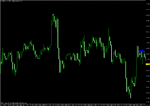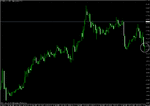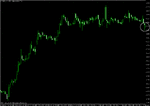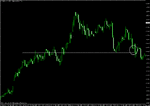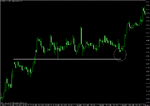OK
Here's a few examples
pic 1 & 2 are on the EURUSD. Hourly 29/11/07 01:00 S/R level, pullback. Result - fail.
Pic 3 & 4 EURUSD 13/3/08 09:00 Hourly, possible swing high, also hit bollinger top. Result - fail.
Hi nunrgguy,
A few points to make:
The thing with this strategy is that it will not appeal to everyone - some people are far too impatient for trading once or twice a week when the perfect setup occurs. Others are averse to the larger stops (despite the fact that with correct position sizing the number of ticks in your stop matters little)
Still, that aside, if you find it fits with your individual trading psychology, this method will make you money consistently. I promise that faithfully to anyone reading this.
Now first and foremost, hit rate in terms of number of wins versus number of losses means next to nothing.
It's how much you win when you win compared to how much you lose when you lose, that makes a difference.
And that is due to:
a) how much you wager
b) how you manage trades in terms of cutting losers and running winners
As an example: I've had a win/loss ratio of well over 90% and still wiped an account out but had another account with a ratio of closer to 50% and made money consistently.
Since you are only talking about the ENTRY when you mention the success rate, let me deal with that next.
As I have said before: if you take ONLY the best setups you will rarely lose.
If you take only the setups that have minimal supporting evidence then you will get a much lower hit rate.
How do you measure how good the setup is? That comes with experience. The strategy is very discretionary and the more you demo it the more you will get a feel for it. What I can tell you is that the more supporting evidence you have, the high probability of the trade working.
Let me look at the setups you mention above:
The first one is important because the level that the pin bar hits is a support level it is NOT a PIVOT. There is a big difference. We are looking for areas where previous resistance has turned into support and vice versa. There is very LIMITED EVIDENCE of that here. The fact that it is a support level which has been hit repeatedly would worry me when taking this because support and resistance levels get ERODED. Sometimes they end up holding but the more they are hit the higher the probability that they are being weakened.
Secondly, you will remember I talk about always planning the trade and a very important part of that plan is identifying the PROBLEM areas. The first PROBLEM area here is where the blue rectangle is since price has recently rejected this area TWICE. Since the R:R is very low you would most likely have wanted to pass on this trade and if you had not, you would almost certainly have wanted to get out for breakeven when price hit it and rejected it for the third time.
Lets look at your other setups.
The second one which is a pin bar at a swing high on the hourly with no supporting evidence is asking for trouble. The higher the TF the more reliable. These types of trades on the hourly TF are not advisable.
I take a lot of these types of trades on the daily TF after extended run ups and these are usually the trades that bring my WIN/lOSS ratio down because many of them fail. So why do I still take them? Because when they work they really go and you can easily cover many losses in one trade.
The one you took on the weekly was a fair enough trade in my opinion and as it happened it didn't work out so I'll give you that one
🙂
I really appreciate all comments - even the negative ones. If someone thinks this strategy is complete BS then tell me!! I'm not going to cry. I know it works for me and I am teaching it to more and more people who are telling me it works for them but if it doesn't work for anyone reading this then I firmly believe there are two reasons:
Either you are taking setups that are not high probability enough (and then not running your winners enough when you get them)
OR
The strategy doesn't suit you e.g. perhaps you tend to over trade and take average setups because of a need to be in the market etc
If you maintain prudent risk management, take only the best setups with the discipline to exit when they dictate you are wrong and maximise the profit by running winners, you cannot fail to make a huge amount of money with this method.

